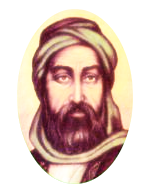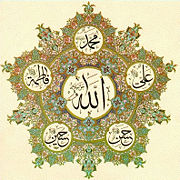Ja'far al-Sadiq
Ja‘far al-Sādiq Imams of Shi'a Islam |
|
 |
|
| Rank | Sixth Twelver/Musta‘lī Imām Fifth Nizārī Imām |
|---|---|
| Name | Ja‘far ibn Muhammad ibn ‘Alī |
| Kunya | Abū ‘Abdillāh[1] |
| Birth | 17th Rabī‘ al-Awwal 83 AH ≈ 20 April 702 C.E. |
| Death | 25th Shawwāl 148 AH ≈ 14 December 765 C.E. |
| Birthplace | Madīnah |
| Buried | Jannatul Baqī‘, Madīnah |
| Life Duration | Before Imāmate: 41 years (83 - 114 AH) - 12 years with his grandfather Imām as-Sajjād - 19 years with his father Imām al-Bāqir Imāmate: 34 years (114 - 148 AH) |
| Titles | *as-Sādiq[1] (Arabic for Truthful) *al-Fādhil[1] (Arabic for Virtuous) *at-Tāhir[1] (Arabic for Pure) *Altinci Ali (Turkish for Sixth Ali) |
| Spouse(s) | Hamīdah al-Barbariyyah[2][3] |
| Father | Muhammad al-Bāqir |
| Mother | Umm Farwa (Fatimah bint Al-Qasim ibn Muhammad ibn Abi Bakr) |
| Children | Mūsá al-Kādhim (Twelver successor) Ismā‘īl ibn Ja‘far (Ismaili successor) Abdullah Al-Aftah, Ishaq, 'Ali al-Uraidhi, al-Abbas, Muhammad, Fatimah, Umm Farwah, Asmaa |

Ali · Hasan · Husayn |
|
Jaʿfar al-Sadiq (702-765; in accurate transliteration, Jaʿfar al-Ṣādiq; Arabic: جعفر الصادق, in full Jaʿfar ibn Muhammad ibn Ali ibn Husayn) is believed by the Twelver and Ismaili Shi'a Muslims to be the sixth infallible Imam (to Nizari, fifth), or spiritual leader and successor to the Islamic prophet Muhammad.[4] He is the last Imam recognized by both Ismaili and Twelver Shi'a sects and the dispute over who was to succeed him led to a division within Shi'a Islam.[4]
Al-Sadiq is said to be highly respected by both Shia and Sunni Muslims for his great Islamic scholarship, pious character, and academic contributions. Although he is perhaps most famous as the founder of Shia fiqh, known as Ja'fari jurisprudence, he had many other accomplishments. As well as being an imam on the shia chain, his presence also graces the Naqshbandi Sufi chain.[1] He was a polymath: an astronomer, alchemist, Imam, Islamic scholar, Islamic theologian, writer, philosopher, physician, physicist and scientist. He was also the teacher of the famous chemist, Jabir ibn Hayyan (Geber), and of Abu Hanifa,[5] founder of a Sunni Madh'hab.
Contents |
Birth and family life
Ja'far al-Sadiq was born in Medina to Umm Farwah bint Qasim ibn Muhammad ibn Abi Bakr on 20 April 702 AD (17 Rabi' al-Awwal, 83 AH). He has the same birthday as that of Muhammad.
Ja'far Al-Sadiq has three titles; they are As-Sadiq, Al-Fadil, and At-Tahir. His father, Muhammad al-Baqir (the fifth Shi’ah Imam), was much happy and pleased by the birth of his son. His mother, Umm Farwa, was the granddaughter of Muhammad ibn Abi Bakr, who was one of the companions of Ali.
Ja'far al-Sadiq was 34 years old when his father, Muhammad "al-Baqir" was killed and he inherited the Imamate.
Marriage and offspring
Jaf'ar married Fatima Al-Hassan a descendant of Imam Hassan who bore him two sons Isma'il ibn Jafar (the Ismaili Imām-designate) and Abd-Allah.
Following his wifes death Al-Sadiq purchased a slave of African origin, Hamidah Khātūn (Arabic: همده خاتون), freed her, trained her as an Islamic scholar, and married her. She bore Mūsá al-Kāżim (the Twelver Imām-designate) and was revered by the Shī‘ah, especially by women, for her wisdom.
Scholarly attainments
As a child, Ja'far Al-Sadiq studied under his grandfather, Ali ibn Husayn. After his grandfather's death, he studied under and accompanied his father, Muhammad al-Baqir, until Muhammad al-Baqir died in 733.
Ja'far Al-Sadiq became well versed in Islamic sciences, including Hadith, Sunnah, and the Quran. In addition to his knowledge of Islamic sciences, Ja'far Al-Sadiq was also an adept in natural sciences, mathematics, philosophy, astronomy, anatomy, alchemy and other subjects.
The foremost Islamic alchemist, Abu Musa Jabir ibn Hayyan, known in Europe as Geber, was Ja'far Al-Sadiq's most prominent student. Ja'far Al-Sadiq was known for his liberal views on learning, and was keen to debate with scholars of different faiths and of different beliefs.
Abu Hanifa an-Nu‘man was an Islamic scholar and Jurist. He was a student of Ja'far Al-Sadiq. [5]
- Scholars believed to have studied extensively with Ja'far Al-Sadiq:
- Jabir Ibn Hayyan - known in Europe as Geber, a great alchemist.
- Musa al-Kazim - his son, the seventh Shi’ah Imam according to the Twelvers
- Isma'il ibn Jafar - his son, the seventh Shi'ah Imam according to the Ismaili
- Sunni scholars who either attended Ja'far Al-Sadiq's lectures or studied with him:
- Abu Hanifa - founder of the Hanafi school of thought.
- Malik ibn Anas - founder of the Maliki school of thought.
- Others that attended lectures by Ja'far Al-Sadiq:
- Wasil ibn Ata - founder of the Mutazilite school of thought.
Jurisprudence
Ja'far al-Sadiq developed Ja'fari jurisprudence at about the same time its Sunni legal fiqh counterparts were being codified. It was distinguished from Sunni law "on matters regarding inheritance, religious taxes, commerce, and personal status."
Under the Umayyad rulers
Ja'far Al-Sadiq lived in violent times. Ja'far Al-Sadiq was considered by many followers of Ali ibn Abi Talib to be the sixth Shi'a imam, however, the Shi'ahs were considered heretics and rebels by the Umayyad caliphs. Many of Ja'far Al-Sadiq's relatives had died at the hands of the Umayyad. Shortly after his father's death, Ja'far Al-Sadiq's uncle, Zayd bin Ali led a rebellion against the Umayyads. Ja'far Al-Sadiq did not participate, but many of his kinsmen, including his uncle, were killed, and others were punished by the Umayyad caliph. There were other rebellions during these last years of the Umayyad, before the Abbasids succeeded in grasping the caliphate and establishing the Abbasid dynasty in 750 CE, when Ja'far Al-Sadiq was forty-eight years old.
Many rebel factions tried to convince Ja'far al-Sadiq to support their claims. Ja'far Al-Sadiq evaded their requests without explicitly advancing his own claims. He is said to burned their letters (letters promising him the caliphate) commenting, "This man is not from me and cannot give me what is in the province of Allah". Ja'far Al-Sadiq's prudent silence on his true views is said to have established Taqiyya as a Shi'a doctrine. Taqiyya says that it is acceptable to hide one's true opinions if by revealing them, one put oneself or others in danger.
The incidents and difficulties, which come into human life can, measure and find out the extent of his energy and faith. The difficulties, which cropped up in the life of Ja'far Al-Sadiq and the patience and forbearance, which, he showed towards them, illuminated his personality and worth. Howsoever they (enemies) abused and teased him he showed patience and forbearance and admonished them. He never cursed or used foul language about them.
Under the Abbasid rulers
The new Abbasid rulers, who had risen to power on the basis of their claim to descent from Muhammad's uncle Abbas, were extremely suspicious of Ja'far, whom many considered to have a better claim to the caliphate. Ja'far was watched closely and, occasionally, imprisoned to cut his ties with his followers. Ja'far endured the persecution patiently and continued his study and writing wherever he found himself.
He died on 14 December, 765. He was poisoned by Al-Mansur, thus becoming a martyr, like the Shi'a Imams before him. He is buried in Madinah, in the famous Jannatul Baqee' cemetery.
Succession
After Ja'far Al-Sadiq's death, there arose a major split between the partisans of the Twelvers and the Ismailis. The Ismailis felt that Isma'il ibn Jafar, originally designated by Imam Ja'far was the rightful successor as the 6th imam. On the other hand, the Twelvers believe that Isma'il ibn Jafar was died in his (Ja'far Al-Sadiq's) life and he felt sorrow and showed his dead body to people to make it sure that Musa al-Kazim, will be his successor. The two groups diverged, with Ismailism being the dominant sect until the fall of the Fatimid Empire and the rise of the Safavid Dynasty which subsequently brought Twelverism to split over the world..
Quotations
1. Whoever attacks a matter without knowledge cuts off his own nose.
2. Intellect is the guide of the believer.
3. The perfection of intellect is in three (things): humbleness for God, good certainty, and silence except for good.
4. Ignorance is in three (things): Arrogance, the intensity of dispute, and the ignorance about God.
5. Certainly, knowledge is a lock and its key is the question.
6. When the believer becomes angry, his anger should not take him out of the truth; and when he becomes satisfied, his satisfaction should not bring him into falsehood.
7. Some manners of the ignorant are: the answer before he hears, the opposition before he understands, and the judgment with what he does not know.
Anecdotes
Someone once asked Ja'far Al-Sadiq to show him God. The Imam replied, "Look at the sun." The man replied that he could not look at the sun because it was too bright.
Ja'far Al-Sadiq replied: "If you cannot see the created, how can you expect to see the creator?"
See also
- Muhammad
- Ali ibn Abu Talib
- Hussain ibn Ali
- Ali ibn Hussayn
- Muhammad al-Baqir
- Musa al-Kazim
- Ali al-Rida
- Muhammad al-Taqi
- Ali al-Hadi
- Hasan al-Askari
- Muhammad al-Mahdi
- Abbas ibn Ali
- Qasim ibn Hassan
- Muhammad ibn al-Hanafiyyah
- Shi'a Islam
- Aban ibn abi-Ayyash
- Ja'fari jurisprudence
Notes
- ↑ 1.0 1.1 1.2 1.3 A Brief History of The Fourteen Infallibles. Qum: Ansariyan Publications. 2004. pp. 123. ISBN 964-438-127-0.
- ↑ A Brief History of The Fourteen Infallibles. Qum: Ansariyan Publications. 2004. pp. 131. ISBN 964-438-127-0.
- ↑ "The Infallibles Taken from Kitab al Irshad By Sheikh al Mufid". al-islam.org. Retrieved on 2008-11-20.
- ↑ 4.0 4.1 "Ja'far ibn Muhammad." Encyclopædia Britannica. 2007. Encyclopædia Britannica Online.
- ↑ 5.0 5.1 http://lexicorient.com/e.o/6thimam.htm
References
- Muhammed Al-Husain Al-Mudaffar, Imam Ja'far al-Sadiq.
- Sayyid Mahdi as-Sadr, THE AHLUL-BAYT Ethical Role-Models.
- Mohammad Hussein il Adeeb, The Brief History of the Fourteen Infallibales.
External links
- Ja'far ibn Muhammad, an article of Encyclopedia Britanica Online
- Imam Ja'far as-Sadiq's life according to a Sunni Sufi source (Naqshbandiya Mujaddidiya Khalidiya Haqqaniya Tariqa of Sufism)
- THE LIFE OF IMAM AL SADIQ(AS) BY SHEIKH MOHAMMED AL HUSAYN AL MUZAFFAR TRANSLATED BY JASEEM RASHID
- Mufaddal - Hadith on wonders of Nature- Imam Jafar al Sadiq (as)
- The Sixth Imam
- Imam Al-Sadiq
- Biography of the Sixth Imam by Sheikh al-Mufid
- Proof that Abu Hanifa was a student of Imam Jafar
|
Ja'far al-Sadiq
Banu Hashim
Cadet branch of the Banu Quraish
Born: 17th Rabī‘ al-Awwal 83 AH ≈ 20th April 702 CE Died: 25th Shawwāl 148 AH ≈ 14th December 765 CE |
||
| Shī‘a Islam titles | ||
|---|---|---|
| Preceded by Muhammad al-Baqir |
Imam - VI of Twelver-Mustaali 743 – 765 |
Succeeded by Musa al-Kadhim |
| Preceded by Muhammad al-Baqir |
Imam - V of Nizari Ismaili 743 – 765 |
Succeeded by Ismail bin Jafar |
|
|||||||||||||||||